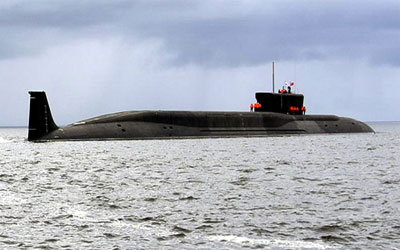By FnF Desk | PUBLISHED: 17, Dec 2014, 17:38 pm IST | UPDATED: 17, Dec 2014, 17:38 pm IST

New Delhi: India's first nuclear attack submarine Arihant began sea trials on December 15 with naval personnel and defence scientists onboard showing both caution and confidence.
The 6,000-tonne boat, equipped with an 80MW Indian-designed and built pressurised water reactor, sailed out of the Shipbuilding Centre (SBC) at the Naval Dockyard in Visakhapatnam on Monday morning, smoothly exiting the enclosed harbour from its narrow mouth into the open sea.
Significantly, the jet black beauty moved under its own power as India’s newly-appointed Defence Minister Manohar Parikkar congratulated the Navy and defence scientists and wished good luck to those on board.
There was no official announcement but a day later, on December 16, Parikkar confirmed the development as a “milestone” while speaking to newsmen on the sidelines of a function here to mark Vijay Diwas (Victory Day) commemorating the end of the 1971 Bangladesh Liberation War.
Sources told India Strategic (www.indiastrategic.in) that the Navy and Indian Air Force (IAF) had deployed their respective Mig 29Ks and SU 30 combat jets around the harbour while Boeing P-8I maritime surveillance and attack aircraft from the nearby naval base of INS Rajali at Arakkonam sanitised the area for any hostile underwater activity. The Navy has six of the eight aircraft ordered already in service. Ships of the Navy's Eastern Command, which is also located in Visakhapatnam, were appropriately deployed.
Indications of Arihant’s open sea movement was given by the Navy Chief, Admiral Robin Dhowan, on December 3 when he said the sea trials would begin “very soon.” More than his statement, it was his smile that indicated the imminence of the event.
The project coordinator for the nuclear-propelled nuclear attack (SSBN) submarines is the Indian Defence Ministry’s Defence Research and Development Organisation (DRDO) with a lead role played by the Bhabha Atomic Research Centre (BARC) scientists. The Navy, which is to operate the boat, has provided officers and men trained by BARC, and some of those on board have experience of operating INS Chakra, India’s nuclear propelled (but not nuclear attack) submarine (SSN) supplied by Russia.
India plans to have a fleet of five Arihant class SSBN submarines to complete its nuclear triad towards deterrence. India has a No First Use (NFU) policy but in case of attack, it also declares massive retaliation for the enemy.
Arihant should have been out in the sea for trials in the earlier half of 2014 but due to the complexity of the systems, checks were done again and again. In March however, there was a small accident at the harbour, and although it was unrelated to the submarine, it was considered prudent to go in for rechecks and more rechecks.
As for Arihant, DRDO chief Dr Avinash Chander had told India Strategic in an interview recently that "the missiles and other combat systems for Arihant have been ready due to their parallel development, and as the trials mature, they would be fitted on board and tested one by one".
India also has a policy of No Nuclear Tests after its 1998 experiments, and, accordingly, as and when the onboard weapons are fired from underwater, they would have dummy warheads.
It may be recalled that Russia, which has so far lent two nuclear (SSN) boats to India - there was an earlier INS Chakra in the 1980s also - has helped in building the miniature nuclear reactor for Arihant. However, the reactor of Arihant is considered slightly underpowered, and the subsequent boats should have more powerful reactors going up to 100 mw.
Nonetheless, Russia's contribution has been acknowledged by the Indian government several times. The Russians also helped in building the naval base in Visakhapatnam, and a section of the Officers Mess at the base is named Kremlin, the historic seat of rulers in Russia.

by : Priti Prakash
Into this devastation walked Donald Trump with his much-hyped 'peace plan'. At first glance, it soun...